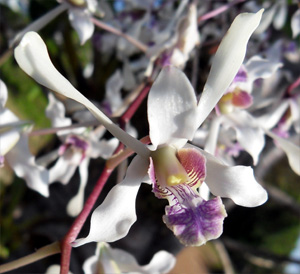
Brassavola is a genus of 21 orchids. They were named in 1813 by the Scottish botanist Robert Brown. The name comes from the Italian nobleman and physician Antonio Musa Brassavola. This genus is abbreviated B. in trade journals.

Phragmipedium is a genus of the Orchid family (Orchidaceae) and the only genus comprised in the tribe Phragmipedieae and subtribe Phragmipediinae. The name of the genus is derived from the Greek phragma, which means "division", and pedium, which means "slipper". It is abbreviated 'Phrag' in trade journals.

Laelia is a small genus of 25 species in the orchid family (Orchidaceae). Laelia species are found in areas of subtropical or temperate climate in Central and South America, but mostly in Mexico. Laelia is abbreviated L. in the horticultural trade.

Cattleya aclandiae, or Lady Ackland's cattleya, is a species of orchid from the genus Cattleya, named in honor of Lady Lydia Elizabeth Ackland, wife of Sir Thomas Dyke Acland, 10th Baronet who was the first European to grow the plant successfully. The illustration of the plant which accompanied its first description was based on a drawing by Lady Ackland. The genus was named in honour of William Cattley, a prominent British merchant and horticulturist.

Odontoglossum crispum, the curled odontoglossum, is an epiphytic orchid from the genus Odontoglossum. It is considered by many to be the most beautiful orchid of all but is also one of the most difficult to grow.

Paphiopedilum insigne is an Asian species of slipper orchid and the type species of the genus Paphiopedilum. Its name is derived from the Latin insigne, meaning 'badge of honor' due to the magnificent flower. In the 19th century it was very popular among European and American orchid growers, causing it to become very rare in the wild due to over collecting. There are many varieties of it and hybrids with it.
Encyclia fehlingii is a species of orchid that was named for Gladys Fehling who lived on Andros Island in the Bahamas and spent much of her time searching for the orchids of the area and growing them for her own pleasure. The plants of Encyclia fehlingii are eiphytic and grew mostly in the Fresh Creek area on Andros, but the species has also been found on New Providence Island and on Abaco.
Epidendrum smaragdinum is an epiphytic sympodial orchid native to the Neotropics. It has been found at 0.5 km above sea level in Napo, Ecuador It is also known from Brazil, French Guiana, Guyana, Peru, Suriname, and Venezuela.

Epidendrum sophronitisLinden & Rchb.f. (1857) is a small Epidendrum orchid that bears a superficial resemblance to a Sophronitis, as the generic epithet was used prior to the year 2000.
Epidendrum parvilabre is a sympodial terrestrial orchid native to the mountainous (~2 km) tropical rainforests of Ecuador and Piura, Peru.

Epidendrum catillus is an epiphytic orchid native to Colombia, Ecuador and Peru at altitudes ranging from 0.8 km to 1.6 km.

Cattleya rex is a species of epiphytic orchid of showy white flowers, native to montane forests in Peru and Bolivia.
Epidendrum cochlidium is a neotropical orchid which can grow both terrestrially and epiphytically in Peru and Venezuela at altitudes ranging from 1.2 km to 2.9 km.

Epidendrum coriifolium is a sympodial orchid which grows both terrestrially and epiphytically at altitudes of 1.4—1.7 km in dense forests in Brazil, Ecuador, Mexico, Central America, and Venezuela.

Epidendrum fimbriatum is a terrestrial orchid native to high altitudes (2.2—3.4 km) in Bolivia, Colombia, Ecuador, Peru, and Venezuela.

Psychopsiella is a monotypic genus in the orchid family found only in the state of Rio de Janeiro in Brazil and near Caracas in Venezuela. It grows as an epiphyte in evergreen montane forests at elevations of 800 to 1,500 metres.

Encyclia citrina is a species of orchid with a strong lemon fragrance. Its petals are golden yellow with varying degrees of white crenulations in the lip. The plant may be upright or pendant, but the flowers are always pendant. It is also known as the tulip orchid due to its flowers' rounded cup-like shape. It has been referred to for generations as costicoatzontecoxòchitl, meaning "flower in the form of yellow serpent head", by the Nahuas.

Dendrobium lineale is a species of orchid. It is an epiphytic plant that grows along the north-eastern coast of New Guinea, from Milne Bay to just over the border into the Indonesian Province of Papua, and from sea level to around 800 metres (2,600 ft). It has cane-like pseudobulbs which grow up to 2 metres long and 2–3 centimetres (0.8–1.2 in) in diameter. Its inflorescences are up to 75 cm (30 in) long with many flowers, up to 5 cm (2.0 in) across. Its leaves are oblong or lanceolate, and up to 15 cm (6 in) long. They last two to three months and bloom throughout the year in the native habitat.

Cattleya iricolor is a species of orchid native to the eastern montane forests of Ecuador and Peru.

Encyclia candollei is a species of epiphytic orchid of yellow-brown to reddish flowers, native to Belize, Guatemala and Mexico.

















